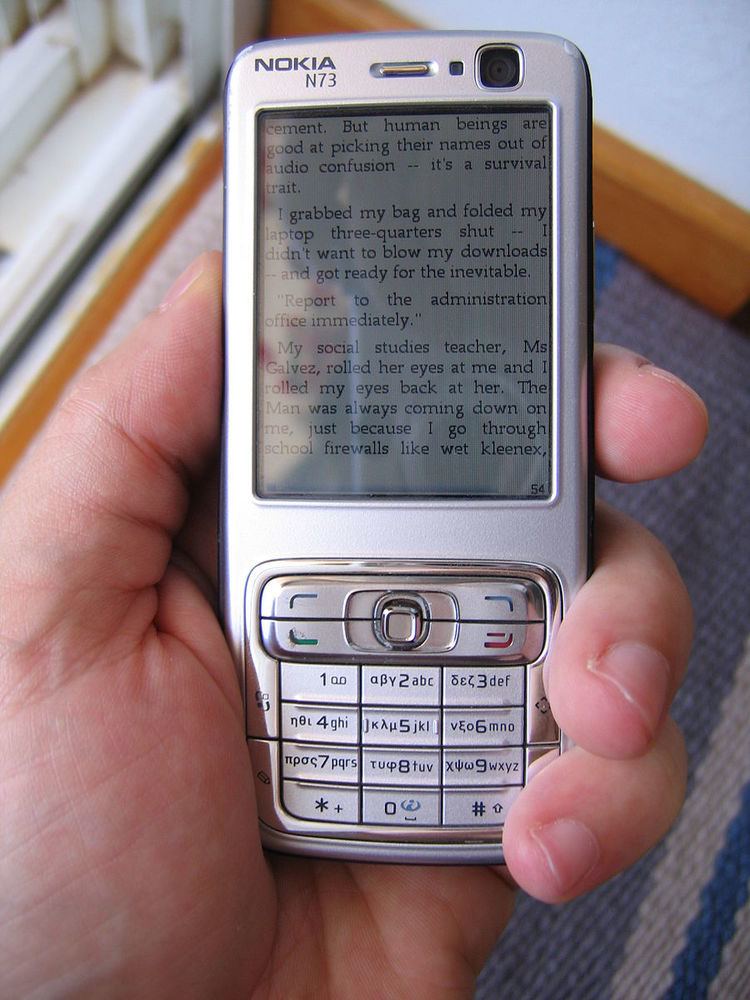An e-reader, also known as an e-book reader, is a portable electronic device that is designed primarily for the purpose of reading e-books and periodicals. E-book readers are similar in form to a tablet computer, and usually refer to readers that use electronic paper, resulting in better screen readability, especially in bright sunlight, and longer battery life. When disconnected from the web, an e-book reader's battery will last many weeks. In contrast to an e-book reader, a tablet computer has a faster screen capable of higher refresh rates which makes them more suitable for interaction such as from a video game.
Any device that can display text on a screen can act as an e-reader, but without the advantages of electronic paper. On the other hand, most e-books are read on devices not specifically designed for reading e-books, such as laptop computers, smartphones, and tablets.
All electronic paper types offer lower power consumption and better sunlight contrast than LCDs. Some offer a backlight to allow for low-light reading. With the backlight turned off, all have a similar appearance to "ink on paper" and are readable in bright environments.
E ink: E Ink Corporation's 1st generation technology, also known as E Ink Vizplex. Although "eInk" may be used to talk about all electronic paper displays, "eInk" and "E Ink" are trademarked by E Ink, which provides the majority of the electronic paper displays used in devices.
E Ink Pearl: E Ink's 2nd generation technology, which has higher contrast and a greater number of different levels of gray than their earlier technology. A further revision of Pearl is Mobius, which uses flexible plastic in the display.
E Ink Triton: E Ink's 3rd generation technology that featured the ability to show color in the display.
E Ink Carta: E Ink's 4th generation technology, which has higher contrast and a greater number of different levels of gray than their earlier technology and the displays have between 212 and 300 pixel density.
SiPix: A former competitor to E Ink, which had displays with almost instantaneous page turns. It was acquired by E Ink in December 2012.
LG Flex: Electronic paper that allows for a flexible screen, that is still in development. With these displays, the user is able to bend the e-reader without damaging it and can fold it up to put in a pocket.
Notes:
Library DRM compatible – Can be used to borrow e-books from public libraries, e.g. the EPUB and/or PDF formats with digital-rights-management (DRM) are supported.
"microSDHC" is the most popular format for external memory cards. Devices which support a different card have that format listed.
Listed are only products for which either the product itself or its company is notable, as shown by having a Wikipedia article (without notability notice).
Some common hardware is resold in different national markets under various brand names. Below are the brand names associated with the generics in the above table: generic 6" touchscreen (2010): bq Movistar, bq Avant, egriver Touch (India), postitivo Alfa (Brazil), e-vrit (Israel), Papyre 6.2 (Spain).
See Comparison of e-book formats for details on the file formats.
The most notable formats are:
.epub is a free and open e-book standard used by most e-book readers.
.azw is Amazon’s proprietary e-book file format for the Kindle.
This list is missing many of the 1st and 2nd generation e-reader devices from the 1990s to 2005.
This list can be expanded by adding Unicode support information for e-readers. Such information is very difficult to find right now.
Rebranded devices
Hanlin V3 → BeBook (EU): BeBook, Koobe (HU), Astak EZ Reader (US), Lbook V3 (UA), Papyre 6.1 (E1/E2) (ES)
Hanlin V60 → LBook V60 (UA), Papyre 613 (v1/v2)(ES), E-Reader Onda Biblet TB600KT con WiFi e 3G(IT), Koobe Be Free(HU)
Netronix EB001 → Astak Mentor EZ Reader, Cybook Gen3 (200 MHz version)
Netronix EB600 → Cool-er, eClicto, Elonex eBook, eSlick, Astaka Mentor EZ Reader, Cybook Gen3 (400 MHz version)
Condor eGriver touch → Medion OYO, Prestigio PER5062B, Icarus Sense, Pandigital Novel 6" Personal eReader, Qisda QD060B00
TrekStor eBook Reader 3.0 → Prestigio Nobile PER3172B
Papyre 601 → Wexler E6003, Prology Latitude I-601, Ritmix RBK-600, Assistant AE-601, DNS Airbook EYT601, Texet TB-146
All modern (Windows Mobile, iOS, Android, BlackBerry, Linux) smartphones, tablets and other generic computing devices have e-book reading software.
Some portable multimedia players and older phones include a text viewer, e.g. several Cowon players, including the Cowon D2 and the iAUDIO U3 and Mobipocket Reader for Symbian OS. Palm OS based devices and smartphones are also usable for reading books. Palm OS supports PalmDoc, iSilo, Mobipocket reader, PDF, HTML conversion, text format, Handstory, TealDoc among many other software titles, and word processing.

